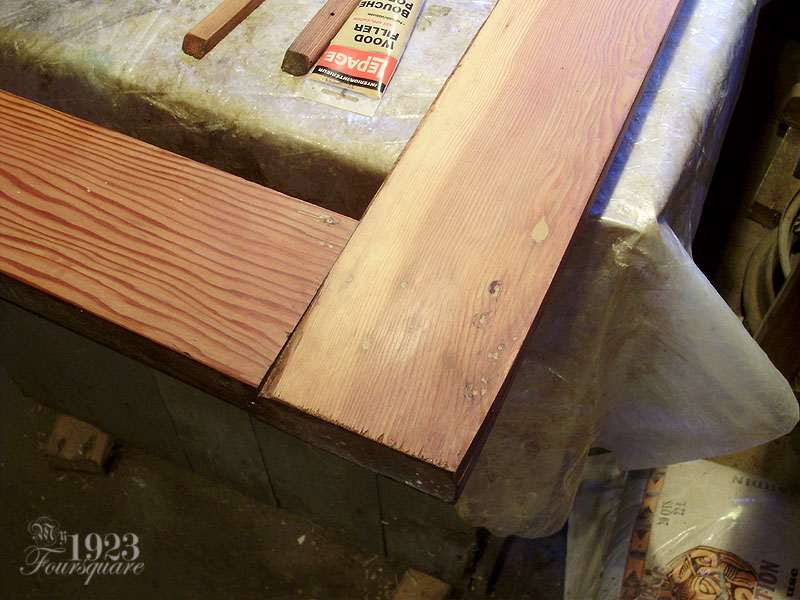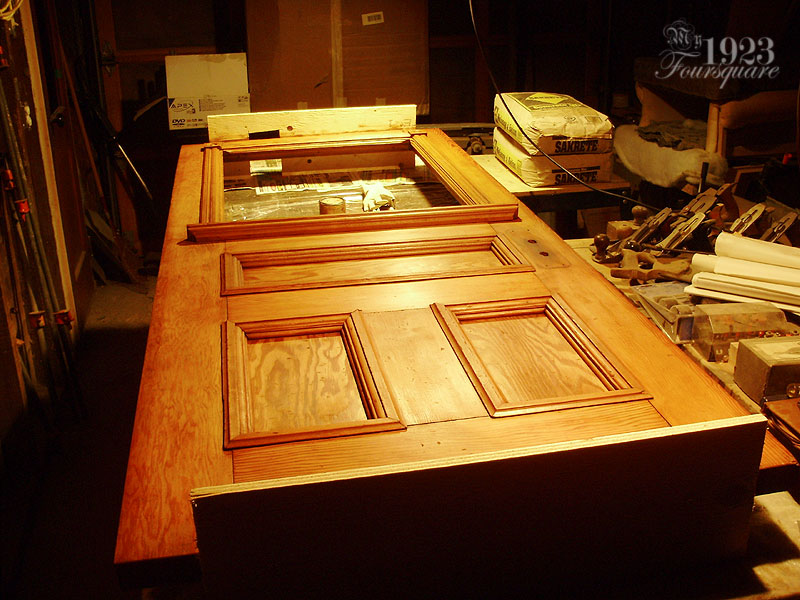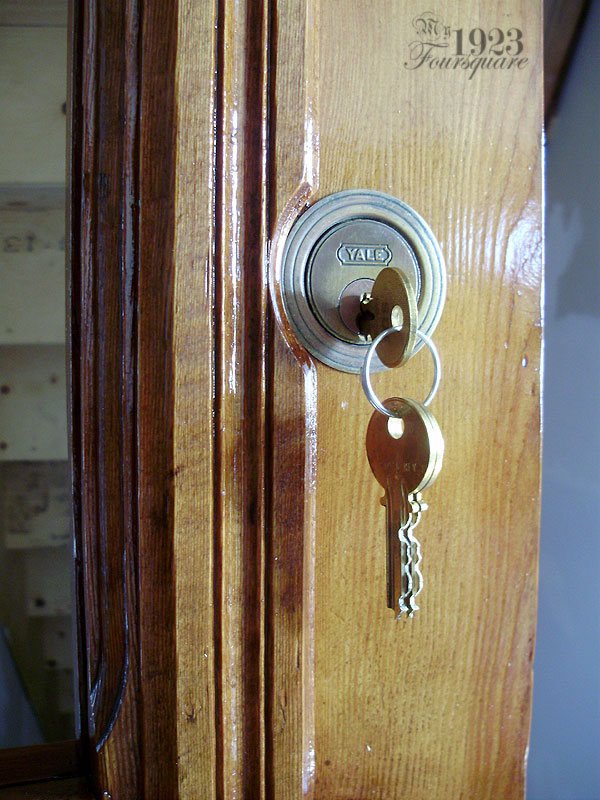With the door fully stripped clean of the old finish, now I can turn my attention to all the woodworking aspects of the repairs. This includes a wedge shaped wood patch, filling nail holes, a plug patch (not shown), trimming the top and bottom of the door, and drilling a hole for the deadbolt.
Here you can see where a sliver of wood (a fairly large one) has been broken away from the door frame (at the top on the interior side). If this were smaller, it could be left as "character", or putty-filled, but since it was so large, it was a better candidate for a wood patch.

The hole was enlarged slightly and cleaned-up to have clean lines, then a scrap piece of antique BC Fir was cut and sanded to fit the hole. This was glued and clamped with waterproof exterior PVA glue.

I had made sure to match the wood grain, but since the piece was oversized, and at a slight angle, once it was trimmed and sanded flat, the grain no longer matched. The important part is that it's a nice tight fit, and that it's the same species. I will try to blend the finish to hide the repair as much as possible.

Not shown is another similar repair where I had to patch a shallow 3/4" round hole on the bottom edge of the door. I have no idea if this was for a bolt or for a security system, but the hole was only about 5/8" deep, clean/unfinished, and with no other screw holes near it. I simply cut a plug, hammered it in place, trimmed it, sanded it, and stained it.
One other problem with the door was that all 4 corners (the door upright side pieces) had about a 1/8 overhanging past the centre boards. This may or may not be a big deal (depending on the installation), but because I plan to use bronze weatherstripping, I need a straight/flat surface for the weatherstripping to work well. All 4 corners were trimmed flush with the centre boards (see photo above). I used a guide and a router for this, since there's no way to lift this door onto my dinky table saw, and a hand held circular saw would have made a very rough cut.

Once all the repairs were done, the entire door was given a coat of light stain. This is just enough to liven-up the colour, as well as blend together any light spots. It also helps to highlight the details in the mouldings, and it hides all the puttied nail holes.

VARNISH!
Most people tend to gravitate towards standard "Poly" (Polyurethane) varnish, or to these new water based acrylic finishes (which I absolutely hate) but for this door, I SPECIFICALLY wanted Yacht varnish (also known as spar varnish). I plan to use spar varnish for all the doors and floors (eventually) in the house. My father refinished his maple floors in the late 1970s using spar varnish (with a yellow-gold tint added to it) and the floors STILL LOOK GREAT over 30 years later. They have very light scuffing and scratches, but the colour, and the gloss are still excellent, and this sold me on the idea of using this varnish. When I was a teen, we finally got the floors upstairs installed (parquet), sanded, and finished, and they used some kind of Poly, and I hated the look and feel of it. It looked bland, and it felt very thin.
A comment also reminded me of another short "spar varnish story". My father had also done a refinishing job on some garage doors for a client/friend. He used spar varnish on them, and I believe it's been over 20 years (these are exposed to weather constantly) and they still look amazing. The client was amazed at how long the finish lasted, and how well it performed.
Some of the pros of spar varnish are that it contains UV blockers, it is also resistant to: salt water (it's designed for wooden boats), heat, abrasions, gasoline, diluted acids, and diluted alkalis. Another pro is that since it is oil based, it flows and becomes much smoother than a water based finish. It's also harder and more durable. It's also fairly easy to find, and very affordable (14$/quart, 40$/gal).
Cons: It is slow drying (6 hours touch-dry, 24 hours to recoat), it's messy for brush cleaning (oil based/paint thinner clean-up), it's very smelly, and 3 thin coats are recommended.
I should also add that as far as application, smell, and cleanup, spar varnish is about the same as Poly.
Because of the drying time needed, and the difficulty in flipping/rotating the door, it will take 6 days to varnish (3 coats per side at one day each).



This shows the modifications I had to make in order to fit the deadbolt. The moulding was in the way, so I had to remove it, trim it, and route it to match. I think it will look very good. I would have preferred not to need to do this at all, but the door only had the original skeleton key mortise lock, and that's not at all secure for a front door. The deadbolt I'm using is a salvaged antique YALE lock, and it uses a modern 5-pin tumbler lock (I've already had keys made for it).

The actual colour is not nearly this dark/bright (more like the photo above), but isn't that wood grain just simply gorgeous? To think this door was headed for the landfill! I even love the little nicks and scratches. The varnish is gloss, but it's photographed while it's still wet. It won't look exactly like this once it's done.



































